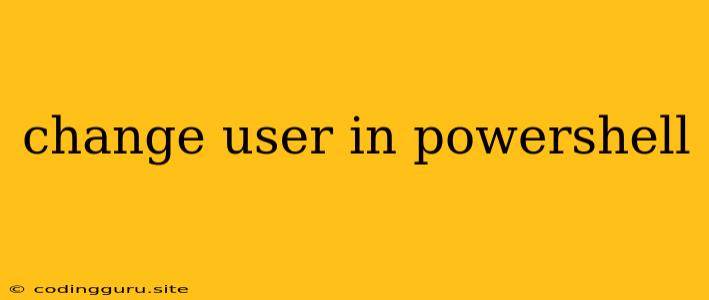How to Change User in PowerShell
PowerShell is a powerful command-line shell and scripting language used for automating tasks in Windows. One common task is changing the user account you're currently logged in as. This can be helpful when you need to perform tasks with different permissions or need to access resources only available to another user.
Understanding the Process
Changing users in PowerShell involves changing the user context in your current session. This doesn't mean you're physically logging out of your account and logging in as another user; instead, you're essentially assuming the identity of another user within your existing PowerShell session.
Methods for Changing Users in PowerShell
There are multiple ways to change users in PowerShell. Here are the most common methods:
1. Using RunAs Command
The RunAs command allows you to execute a command as another user. This is a convenient method for running single commands or scripts as a different user.
Syntax:
RunAs /user:domain\username command
Example:
To run the Get-Process command as the user "administrator" on the domain "example.com," you would use:
RunAs /user:example.com\administrator Get-Process
2. Using Start-Process Command with -Credential Parameter
The Start-Process command allows you to start a new process with specific credentials. This is useful for running a program or script as a different user.
Syntax:
Start-Process -FilePath "path/to/program.exe" -Credential (Get-Credential)
Example:
To start the program "notepad.exe" as the user "administrator" with the password "P@$w0rd", you would use:
$credential = Get-Credential
Start-Process -FilePath "C:\Windows\System32\notepad.exe" -Credential $credential
Note: You will be prompted to enter the password for the specified user.
3. Using New-PSDrive Command
The New-PSDrive command creates a new PowerShell drive that maps to a specific user's profile. This allows you to navigate and access files within that user's profile.
Syntax:
New-PSDrive -Name "profile" -PSProvider FileSystem -Root "C:\Users\username" -Credential (Get-Credential)
Example:
To create a drive called "profile" that maps to the user "administrator's" profile, you would use:
$credential = Get-Credential
New-PSDrive -Name "profile" -PSProvider FileSystem -Root "C:\Users\administrator" -Credential $credential
You can then access the user's profile by navigating to the "profile" drive:
cd profile
4. Using Invoke-Command with -Credential Parameter
The Invoke-Command cmdlet allows you to execute commands on remote computers, including changing the user context.
Syntax:
Invoke-Command -ComputerName "computername" -Credential (Get-Credential) -ScriptBlock { command }
Example:
To execute the Get-Process command on the computer "server1" as the user "administrator," you would use:
$credential = Get-Credential
Invoke-Command -ComputerName "server1" -Credential $credential -ScriptBlock { Get-Process }
5. Using Enter-PSSession with -Credential Parameter
This method allows you to establish a persistent PowerShell session with a different user on a remote computer.
Syntax:
Enter-PSSession -ComputerName "computername" -Credential (Get-Credential)
Example:
To establish a persistent PowerShell session on the computer "server1" as the user "administrator," you would use:
$credential = Get-Credential
Enter-PSSession -ComputerName "server1" -Credential $credential
You can then run commands as the specified user within the remote session. To exit the session, use Exit-PSSession.
Tips for Changing Users in PowerShell
- Use strong passwords: When using credentials, ensure you're using strong passwords to protect sensitive information.
- Use the correct domain: When specifying the user name, remember to include the domain name if applicable (e.g.,
domain\username). - Test with simple commands: Before running complex scripts, try changing users with simple commands to ensure the process is working correctly.
- Remember to exit sessions: If you're using persistent sessions, remember to exit them using
Exit-PSSessionwhen you're finished. - Use
Get-Credentialfor secure input: Use theGet-Credentialcmdlet to prompt the user for credentials in a secure way, preventing passwords from being displayed on the screen.
Conclusion
Changing users in PowerShell is a powerful technique that can be used for various purposes. By mastering these methods, you can effectively manage your tasks with different user accounts and permissions, ultimately making your work with PowerShell more efficient and secure.
